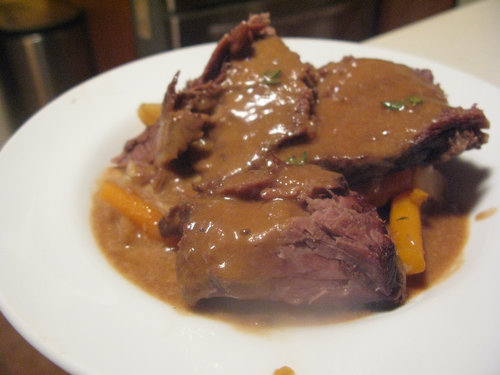I came across this recipe in “An Apple Harvest: Recipes and Orchard Lore” by Frank Browning and Sharon Silva (10 Speed Press). It turns out to be fabulous — and unlike most anything you’ve ever tasted. Try it. You’ll see.
Now normally I would not include a lengthy headnote along with someone else’s recipes, but this one explains so well why this recipe is so, well, unusual, that I feel I must. Read on.
Roman Pork and Apple Stew
All over nothern and eastern Europen, home cooks combine apples and pork into savory stews, probably because pigs ahve always been the most common farmyard meat and apples the most durable and readily available fruit. The earliest recorded pork and apple stew comes to us from Marcus Gavius Apicus’s “Ars Magirica,” a Roman work published around the time of Caesar Augustus. “Minutal Matianu, he called it, Matian being a sweet, aromatic apple prized by the Romans. But the key to this rich, spicy dish is garum, the passion of high Roman cuisine, a pint of which in today’s currency would cost as much as $700.
And what was this jewel of the spice closet? Fermented fish guts. Specialists would disembowel anchovies or mackerel, then place the entrails with a little sea salt and special herbs into a stone jar, set it in a cool cellar, and wait until the concoction had decomposed. Once the decomposition was complete, the thick liquid would be strained and allowed to ferment until ready.
Diluted with water, garum was given to Roman soldiers as a daily tonic. In the kitchen it was mixed with wine, oil or vinegar and stored in carefully marked amphorae — or it was added to the cook pot. As strange as garum might seem to the modern palate, a version of the same thing, called fish sauce, is commonly used in South Asian cuisine. For our recipe, we combine anchovy paste with Thai fish sauce, or, if anchovy paste is unavailable, simply mash tinned anchovies into a paste and add the fish sauce. Don’t be afraid. The result is magnificent.
1 bone-in pork shoulder, 6 to 7 pounds, boned and cut into 1 to 1 1/2-inch cubes (about 4 pounds) (ask your butcher to do this if you want to save time)
2 tablespoons olive oil
2 leeks, including 2 inches of pale green, chopped
3 tablespoons fresh cilantro
1 cinnamon stick, 3 inches long
3 tablespoons anchovy paste, divided
4 tablespoons Thai fish sauce, divided
3 to 4 cups chicken stock
1 carrot, peeled and diced
3 tablespoons chopped fresh mint, plus more for garnish
3/4 teaspoon freshly ground pepper
3/4 teaspoon ground cumin
3/4 teaspoon ground coriander
1/3 cup red wine vinegar or cider vinegar
1 tablespoon honey
2 tablespoons brandy or Cognac
2 medium to large Granny Smith, Newtown, Pippin or other tart green apples, unpeeled, cored and chopped
1 medium to large Fuji, Jonagold, Jonathan or other sweet or sweet-tart apple, unpeeled, cored and chopped
3 tablespoons all-purpose flour
3 tablespoons unsalted butter
In a Dutch oven or other large, heavy pot, warm the olive oil over medium high heat. Working in batches, add the pork cubes and brown well on all sides, 5 to 10 minutes. (You may need to draink some of the released liquid as the pork cooks.) Transfer pork to a plate.
Add the leeks and the cilantro to the oil remaining in the pot and saute about 5 minutes, or until softened. Return the pork to the pot and add the cinnamon stick. Stir 2 tablespoons each of the anchovy paste and fish sauce into the chicken stock until well-combined. Add just enough stock to the pot to cover the meat. Bring to a simmer over medium heat, decrease the heat to low and cook, uncovered, about 45 minutes. (The stew may be prepared up to this point several hours in advance and refrigerated.)
Meanwhile, in a food processor, combine the carrot, mint, pepper, cumin and coriander and grind to a paste. Transfer to a small saucepan and add the vinegar, honey, brandy and the remaining 1 tablespoon anchovy paste and 2 tablespoons fish sauce. Add 1/2 a cup of the cooking liquid. Stir well and bring to a boil over high heat. Decrease the heat to medium and simmer for 5 minutes to blend the flavors.
Stir the apples into the pork mixture, then gradually add the sauce to taste, mixing well. (We used all the sauce.) Continue simmering, uncovered, over low heat for another 30 minutes, or until the apples and pork are tender.
About five minutes before the pork and apples are done, make a beurre manie by working the flour and butter together with your hands to form a paste. Gradually add the beurre manie to the cooking liquid, one piece at a time, stirring to melt the butter. Use only as much as you need to thicken the liquid to a nice consistency. (We used all of it.)
Transfer to a warm serving bowl and garnish with the chopped mint. Serve with rice.









Pingback: Saturday Night Supper: Pork Stew and Recession Sidecars | Sour Cherry Farm